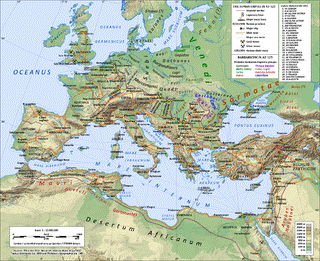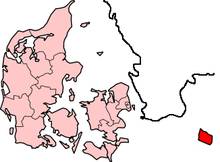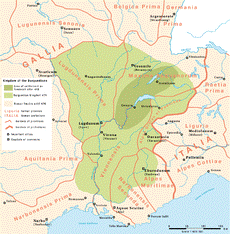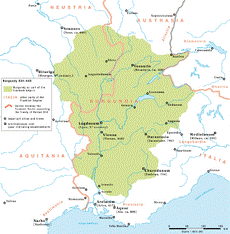
The Roman empire under Hadrian (ruled 117-38),
showing the location of the Burgundiones Germanic group,
then inhabiting the region between the Viadua (Oder) and Visula (Vistula) rivers (Poland)

The Roman empire under Hadrian (ruled 117-38),
showing the location of the Burgundiones Germanic group,
then inhabiting the region between the Viadua (Oder) and Visula (Vistula) rivers (Poland)
Earliest ancestor (45th Great GrandUncle) : Gonthaires Gunderic of the Burgundians (c.390 AD - ?)
The Burgundians (Latin: Burgundiōnes; Old Norse: Burgundar; Old English: Burgendas; Greek: Βούργουνδοι) were an East Germanic tribe which may have emigrated from mainland Scandinavia to the island of Bornholm, and from there to mainland Europe.

Location of the island of Bornholm
The Burgundians' tradition of Scandinavian origin finds support in place-name evidence and archaeological evidence (Stjerna) and many consider their tradition to be correct (e.g. Musset, p. 62). Possibly because Scandinavia was beyond the horizon of the earliest Roman sources, including Tacitus (who only mentions one Scandinavian tribe, the Suiones), Roman sources do not mention where the Burgundians came from, and the first Roman references place them east of the Rhine (inter alia, Ammianus Marcellinus, XVIII, 2, 15). Early Roman sources considered them simply another East Germanic tribe.
About 250, the population of Bornholm (the island of the Burgundians) largely disappeared from the island. Most cemeteries ceased to be used, and those that were still used had few burials (Stjerna, in Nerman 1925:176).
In the year 369, the Emperor Valentinian I enlisted the aid of the Burgundians in his war against another Germanic tribe, the Alamanni (Ammianus, XXVIII, 5, 8-15). At this time, the Burgundians were possibly living in the Vistula basin, according to the mid-6th-century historian of the Goths, Jordanes. Sometime after their war against the Alamanni, the Burgundians were beaten in battle by Fastida, king of the Gepids and were overwhelmed and almost annihilated.
Approximately four decades later, the Burgundians appear again. Following Stilicho's withdrawal of troops to fight Alaric I the Visigoth in AD 406-408, the northern tribes crossed the Rhine and entered the Empire in the Völkerwanderung, or Germanic migrations. Among them were the Alans, Vandals, the Suevi, and possibly the Burgundians. The Burgundians migrated westwards and settled in the Rhine Valley.
Somewhere in the east the Burgundians had converted to the Arian form of Christianity from their native Germanic polytheism. Their Arianism proved a source of suspicion and distrust between the Burgundians and the Catholic Western Roman Empire. Divisions were evidently healed or healing circa AD 500, however, as Gundobad, one of the last Burgundian kings, maintained a close personal friendship with Avitus, the bishop of Vienne. Moreover, Gundobad's son and successor, Sigismund, was himself a Catholic, and there is evidence that many of the Burgundian people had converted by this time as well, including several female members of the ruling family.
Initially, the Burgundians seem to have had a stormy relationship with the Romans. They were used by the Empire to fend off other tribes, but also raided the border regions and expanded their influence when possible.
In 411, the Burgundian king Gundahar or Gundicar set up a puppet emperor, Jovinus, in cooperation with Goar, king of the Alans. With the authority of the Gallic emperor that he controlled, Gundahar settled on the left (Roman) bank of the Rhine, between the river Lauter and the Nahe, seizing Worms, Speyer, and Strassburg. Apparently as part of a truce, the Emperor Honorius later officially "granted" them the land. (Prosper, a. 386)
Despite their new status as foederati, Burgundian raids into Roman Upper Gallia Belgica became intolerable and were ruthlessly brought to an end in 436, when the Roman general Aëtius called in Hun mercenaries who overwhelmed the Rhineland kingdom (with its capital at the old Celtic Roman settlement of Borbetomagus/Worms) in 437. Gundahar was killed in the fighting, reportedly along with the majority of the Burgundian tribe. (Prosper; Chronica Gallica 452; Hydatius; and Sidonius Apollinaris)

The Second Burgundian Kingdom between 443 and 476
The Burgundians were granted foederati status a second time, and in 443 were resettled by Aëtius in the region of Sapaudia. (Chronica Gallica 452) Though the precise geography is uncertain, Sapaudia corresponds to the modern-day Savoy, and the Burgundians probably lived near Lugdunum, known today as Lyon. (Wood 1994, Gregory II, 9) A new king Gundioc or Gunderic, presumed to be Gundahar's son, appears to have reigned from his father's death. (Drew, p. 1) The historian Pline tells us that Gonderic reigned the areas of Saône, Dauphiny, Savoie and a part of Provence. He set up Vienne as the capital of the kingdom of Burgundy. In all, eight Burgundian kings of the house of Gundahar ruled until the kingdom was overrun by the Franks in 534.
As allies of Rome in its last decades, the Burgundians fought alongside Aëtius and a confederation of Visigoths and others in the battle against Attila at the Battle of Châlons (also called "The Battle of the Catalaunian Fields") in 451. The alliance between Burgundians and Visigoths seems to have been strong, as Gundioc and his brother Chilperic I accompanied Theodoric II to Spain to fight the Sueves in 455. (Jordanes, Getica, 231)
Also in 455, an ambiguous reference infidoque tibi Burdundio ductu (Sidonius Apollinaris in Panegyr. Avit. 442.) implicates an unnamed treacherous Burgundian leader in the murder of the emperor Petronius Maximus in the chaos preceding the sack of Rome by the Vandals. The Patrician Ricimer is also blamed; this event marks the first indication of the link between the Burgundians and Ricimer, who was probably Gundioc's brother-in-law and Gundobad's uncle, (John Malalas, 374)
The Burgundians, apparently confident in their growing power, negotiated in 456 a territorial expansion and power sharing arrangement with the local Roman senators. (Marius of Avenches) In 457, Ricimer overthrew another emperor, Avitus, raising Majorian to the throne. This new emperor proved unhelpful to Ricimer and the Burgundians. The year after his ascension, Majorian stripped the Burgundians of the lands they had acquired two years earlier. After showing further signs of independence, he was murdered by Ricimer in 461.
Ten years later, in 472, Ricimer–who was by now the son-in-law of the Western Emperor Anthemius–was plotting with Gundobad to kill his father-in-law; Gundobad beheaded the emperor (apparently personally). (Chronica Gallica 511; John of Antioch, fr. 209; Jordanes, Getica, 239) Ricimer then appointed Olybrius; both died, surprisingly of natural causes, within a few months. Gundobad seems then to have succeeded his uncle as Patrician and king-maker, and raised Glycerius to the throne. (Marius of Avenches; John of Antioch, fr. 209)
In 474, Burgundian influence over the empire seems to have ended. Glycerius was deposed in favor of Julius Nepos, and Gundobad returned to Burgundy, presumably at the death of his father Gundioc. At this time or shortly afterward, the Burgundian kingdom was divided between Gundobad and his brothers, Godigisel, Chilperic II, and Gundomar I. (Gregory, II, 28)
According to Gregory of Tours, the years following Gundobad's return to Burgundy saw a bloody consolidation of power. Gregory states that Gundobad murdered his brother Chilperic, drowning his wife and exiling their daughters (one of whom was to become the wife of Clovis the Frank, and was reputedly responsible for his conversion). This is contested by, e.g., Bury, who points out problems in much of Gregory's chronology for the events.
Circa 500, when Gundobad and Clovis were at war, Gundobad appears to have been betrayed by his brother Godegisel, who joined the Franks; together Godegisel's and Clovis' forces "crushed the army of Gundobad." (Marius a. 500; Gregory, II, 32) Gundobad was temporarily holed up in Avignon, but was able to re-muster his army and sacked Vienne, where Godegisel and many of his followers were put to death. From this point, Gundobad appears to have been the sole king of Burgundy. (e.g., Gregory, II, 33) This would imply that his brother Gundomar was already dead, though there are no specific mentions of the event in the sources.
Either Gundobad and Clovis reconciled their differences, or Gundobad was forced into some sort of vassalage by Clovis' earlier victory, as the Burgundian king appears to have assisted the Franks in 507 in their victory over Alaric II the Visigoth. During the upheaval, sometime between 483-501, Gundobad began to set forth the Lex Gundobada (see below), issuing roughly the first half, which drew upon the Lex Visigothorum. (Drew, p. 1) Following his consolidation of power, between 501 and his death in 516, Gundobad issued the second half of his law, which was more originally Burgundian.

Burgundy as part of the Frankish Empire between 534 and 843
The Burgundians were extending their power over southeastern Gaul; that is, northern Italy, western Switzerland, and southeastern France. In 493 Clovis, king of the Franks, married the Burgundian princess Clotilda (daughter of Chilperic), who converted him to the Catholic faith.
At first allies with Clovis' Franks against the Visigoths in the early 6th century, the Burgundians were eventually conquered by the Franks in 534 after a first attempt in the battle of Vézeronce. The Burgundian kingdom was made part of the Merovingian kingdoms, and the Burgundians themselves were by and large absorbed as well.